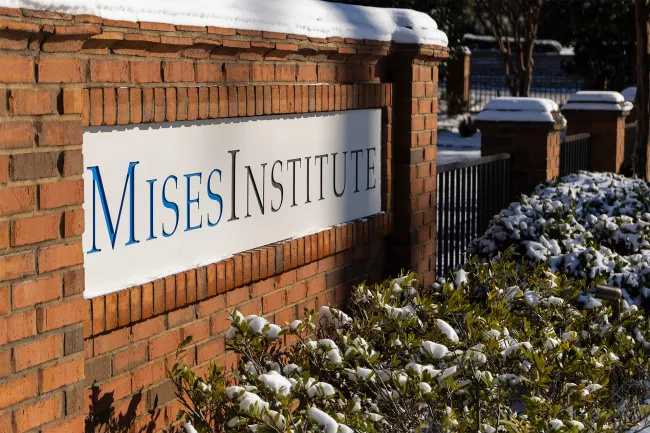In Canada, inflation hit 4.7 percent in October, and is expected to go even higher. According to a recent survey, 46 percent of Canadians are struggling to feed their families because of the rising cost of living. Perhaps they are also struggling to understand the logic of the Bank of Canada’s (BOC) mission statement: “We work to preserve the value of money by keeping inflation low and stable.”
That’s the BOC’s objective, but it’s impossible to achieve. Preserve means to maintain something in its original state, and the only way to preserve the value of money is to keep inflation at 0 percent, not low and stable, as the BOC illogically claims. According to the BOC’s own inflation calculator, the Canadian dollar has lost 22 percent of its value since 2010, and 81 percent of its value since 1990. Given its perpetual failure to achieve its stated goal, why does the BOC continue to exist?
Here’s the answer: the BOC recently announced that “they would stop creating money to buy Government of Canada debt.” That’s the BOC’s real purpose: creating money! It is impossible to preserve the value of a dollar while simultaneously increasing the quantity of dollars (and if the BOC stops creating money, it will only be temporary). Moreover, the Bank of Canada, like all central banks, facilitates money creation through commercial banks.
When the quantity of money increases at a faster pace than the quantity of goods, the result will be tend to be higher prices for goods, services, or assets. Or perhaps all three. Price inflation is caused by monetary inflation, not by supply chain problems, as the BOC claims.
Economic growth does not rely on a predetermined quantity of money. If the quantity of Canadian dollars were eternally fixed, price deflation would probably be the norm. But the BOC warns us that deflation is bad because “a general, persistent fall in prices is usually a symptom of deep problems in an economy.” However, American history says otherwise.
Deflation in American History
As happens today, commercial banks in nineteenth-century America made loans that were not backed by savings in the vault—known as fractional reserve banking. That is, banks would issue paper money (i.e., paper receipts for deposits in the bank) with no money in the vault to back these receipts up. This resulted in monetary inflation. Governments understood how this type of inflation could be used to the state’s advantage.
During the War of 1812 and the Civil War, for example, the government encouraged and legalized banks’ immoral practice of fractional reserve banking, then borrowed unbacked funds from banks to pay war expenses. This inflated supply of unbacked money eventually resulted in higher prices for goods and services. Sensing the fraud, people rushed to the banks to redeem their bank-issued paper money. The government’s response—as you may have guessed—was to grant banks the legal right to refuse redemption while continuing to do business.
Outside of these two war periods, fraudulent increases to the money supply were much less pronounced during most of the nineteenth century compared to the money creation activities of central banks during the twentieth and twenty-first centuries. This relatively stable money supply was accompanied by falling prices during a time of significant economic growth. By the end of the century, the US was on the verge of overtaking Great Britain as the world’s foremost economic power. This puts the lie to the BOC’s claim that falling prices are “a symptom of deep problems in an economy.”

If not for the government’s support for banks’ counterfeiting activities, prices likely would have dropped further. In his book Money, Bank Credit, and Economic Cycles, Jesús Huerta de Soto explains the government’s support for fraudulent money creation:
[The] gradual discovery authorities made of banks’ immense power to create money explains why, in most instances, governments ended up becoming accomplices to banking fraud, granting privileges to bankers and legalizing their improper activity, in exchange for the opportunity to participate, directly or indirectly, in their enormous profits. In this way they established an important alternative source of state funding. Furthermore, this corruption of the state’s traditional duty to define and defend property rights was encouraged by governments’ enormous, recurrent need for resources, due to their historical irresponsibility and lack of financial control. Thus, a more and more perfect symbiosis or community of interests was formed between governments and bankers, a relationship which to a great extent still exists today. (p 39, emphasis added)
That relationship is nurtured through central banks, including the BOC.
Central Banks and Fiat Money
In Canada, the government grants a legal right to the BOC to (a) create money and (b) facilitate additional money creation through the commercial banks—in both cases with minimal human effort. This is called fiat money, and it requires no more time to create $50 billion than it does to create $50.
The BOC is owned by the federal government, which means it does the bidding of the federal government, which primarily involves the BOC’s purchase of financial assets, including federal and provincial bonds, to finance budget deficits. With every purchase, the BOC creates new fiat money out of thin air.
Thus, consistent with Huerta de Soto’s observation, the BOC’s real purpose is to create money for favored groups and purposes (e.g., government salaries, government contractors, government expenses, commercial banks, corporate subsidies and bailouts, etc.). Welfare for the 1 percent. As Ludwig von Mises wrote:
[A] government’s plans concerning the determination of the quantity of money can never be impartial and fair to all members of society. [It] always furthers the interests of some groups of people at the expense of other groups. It never serves what is called the commonweal or the public welfare.
Benefits for the 1%. Costs for the 99%.
Private sector employment is the system through which most Canadians earn their income, which they receive only after their labor has contributed to the production of goods and services. Then they exchange their production (Canadian fiat dollars) for the production (food, clothing, etc.) of other people.
In contrast, when the BOC creates new money, the recipients of this money can purchase goods that others have produced without having to produce anything themselves—while counterfeiters are thrown in jail for doing exactly the same thing.
As the newly created money works its way through the economy, consumer prices—and often asset prices, such as home prices—tend to rise before wages rise. As a recent Angus Reid poll revealed: “[The] majority of the survey’s respondents don’t see their wages increasing fast enough to offset increases to consumer prices.” The same thing is happening in the US and in other countries. Inflation is a hidden tax.
Technically speaking, it is legal to use other forms of money in Canada, but the government actively discourages this with its tax and legal tender laws. Thus, the government’s regulatory environment makes it almost impossible for hardworking Canadians to avoid a rising cost of living by using a different form of money. Canadians are trapped in an inflationary fiat money system. Within this system, the BOC’s mission statement is to preserve the value of money with low inflation, which is mathematically impossible, a massive fraud perpetrated against Canadians.
When legal systems do not hinder people’s freedom to use whatever form of money they wish, people tend to use money whose quantity changes very little over time, because this inspires confidence in the future value of the money. And, as American history reveals, this money freedom tends to not only preserve the value of money, but to increase its value.
The fraud must end. Abolishing fiat money, and restoring money freedom, would allow Canadians to more fully enjoy the fruits of their own labor. Moreover, financing government deficits with newly created money would no longer be possible. Deprived of the hidden inflation tax, if federal and provincial governments are unable to borrow existing money at market interest rates, they must either reduce their spending, or increase the level of visible taxes. And the latter option might disappear, because public resistance to higher visible taxes could force governments to reduce their profligate spending. Isn’t that how democracy is supposed to work?


